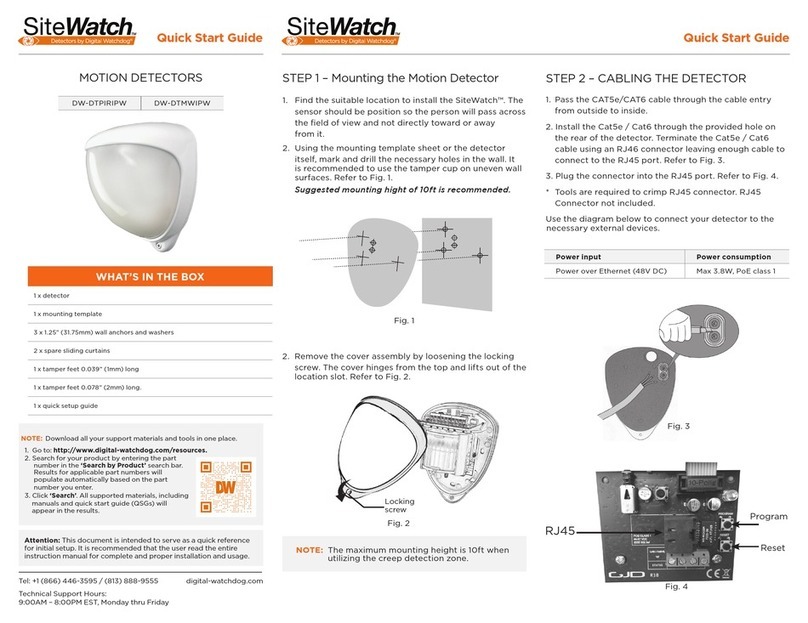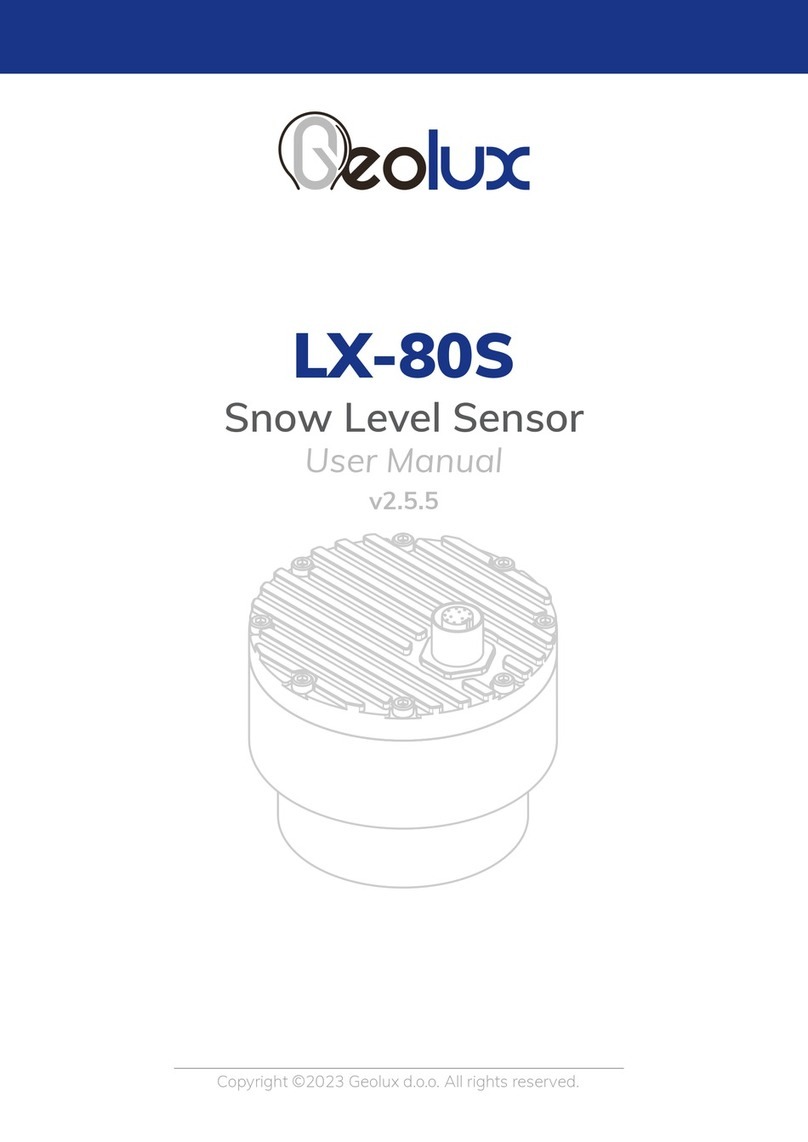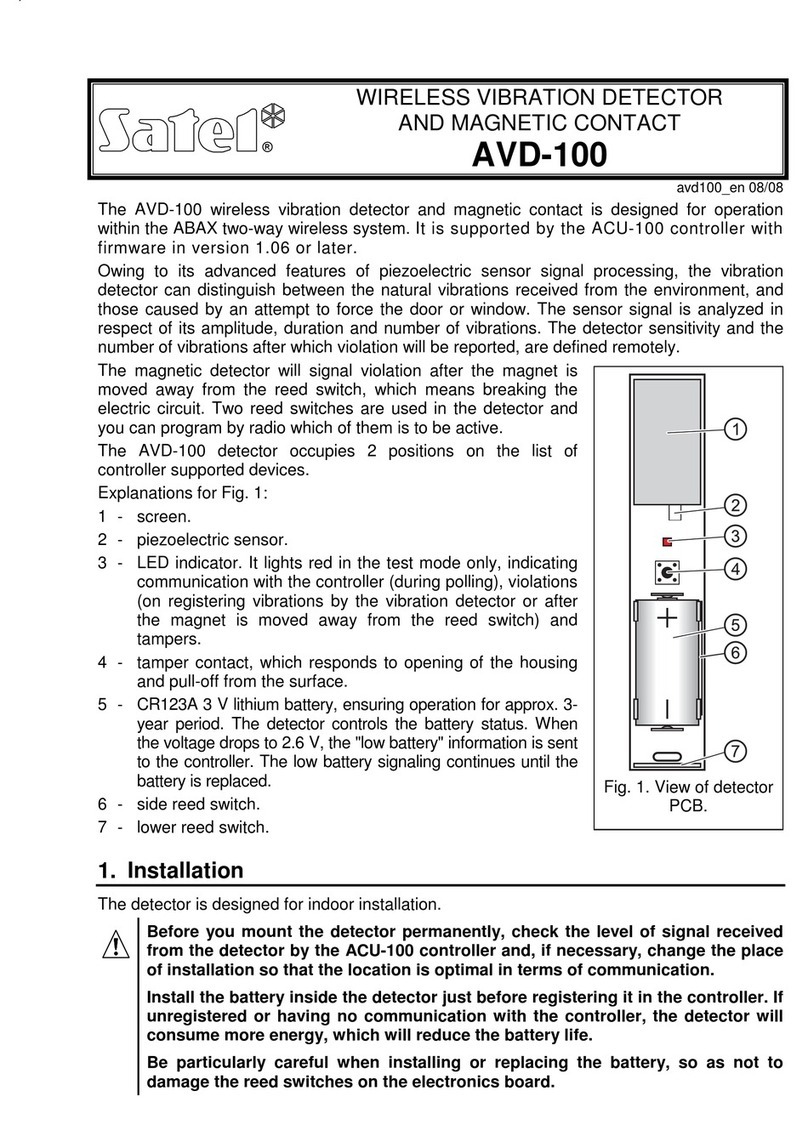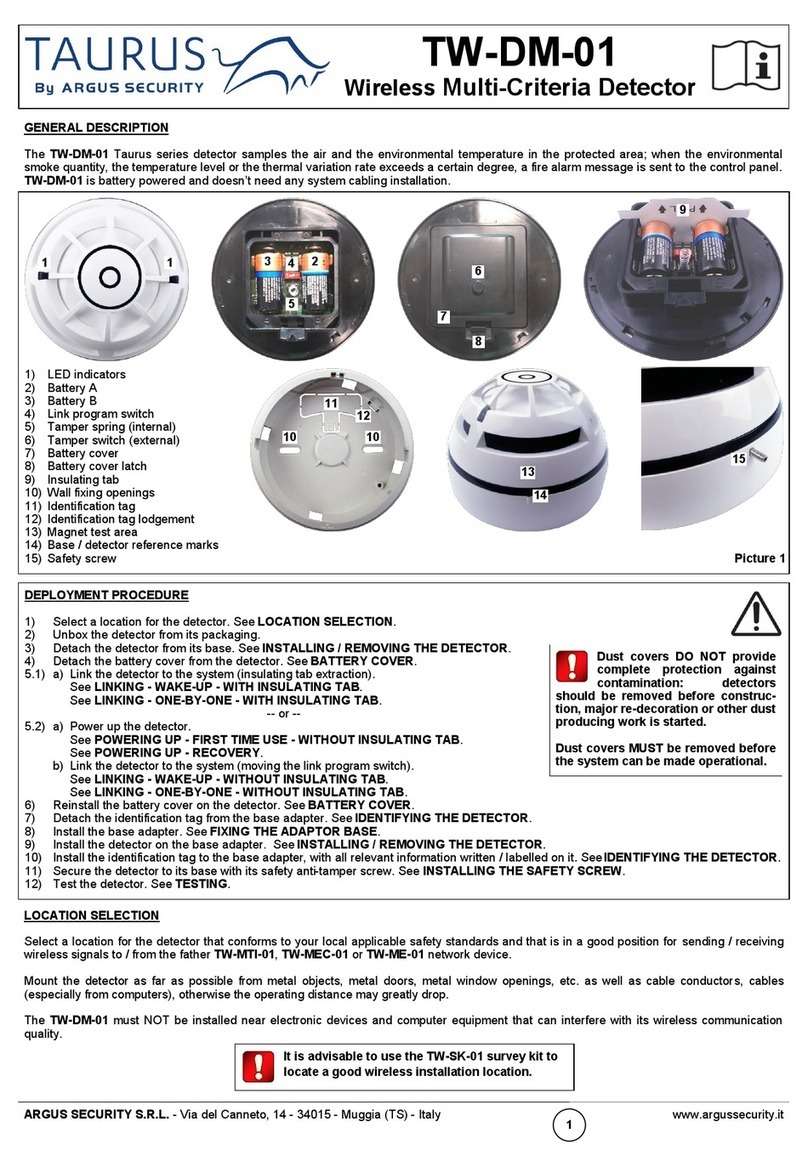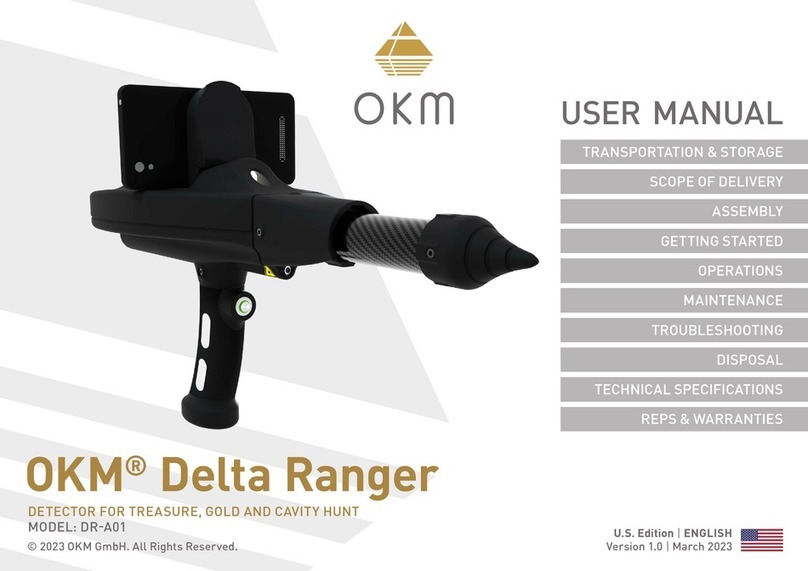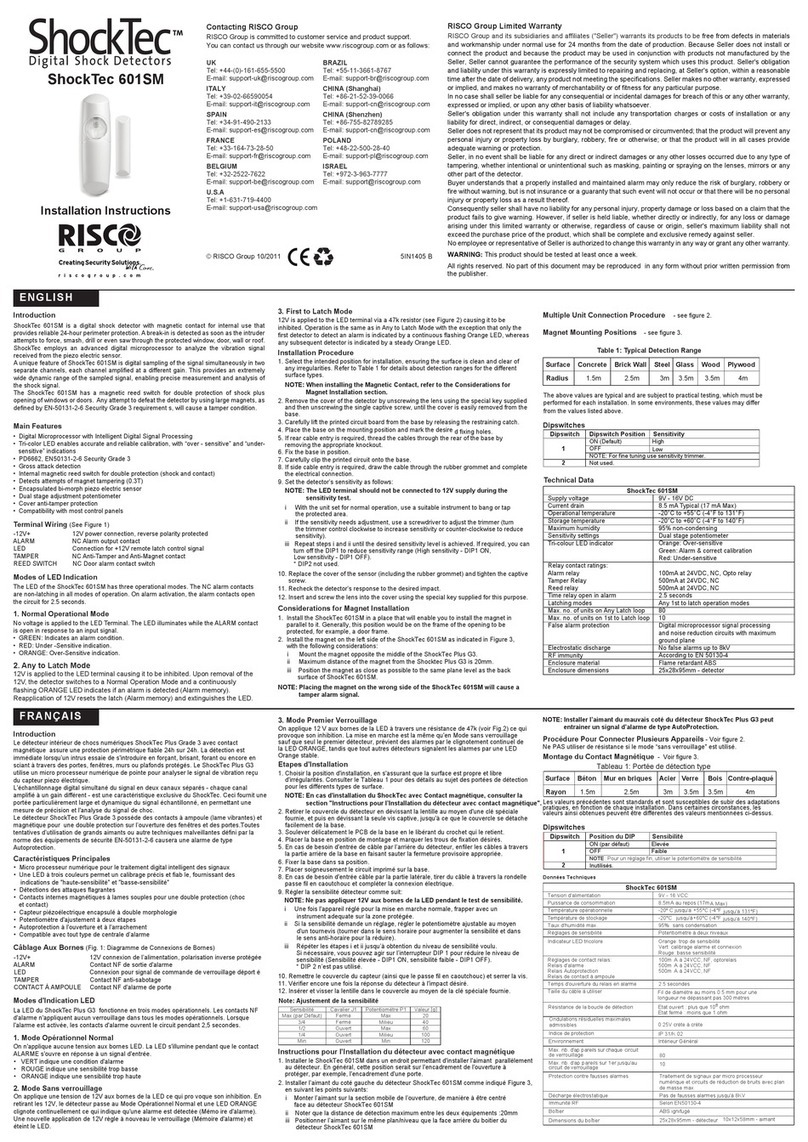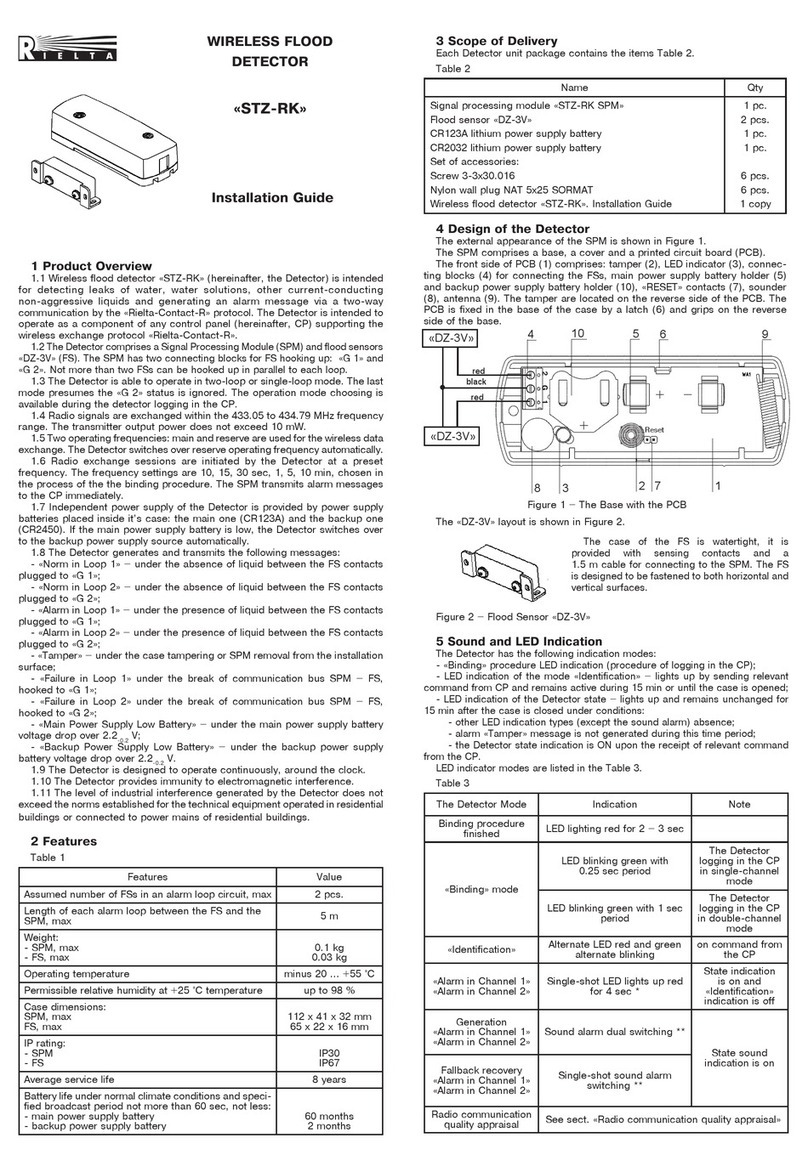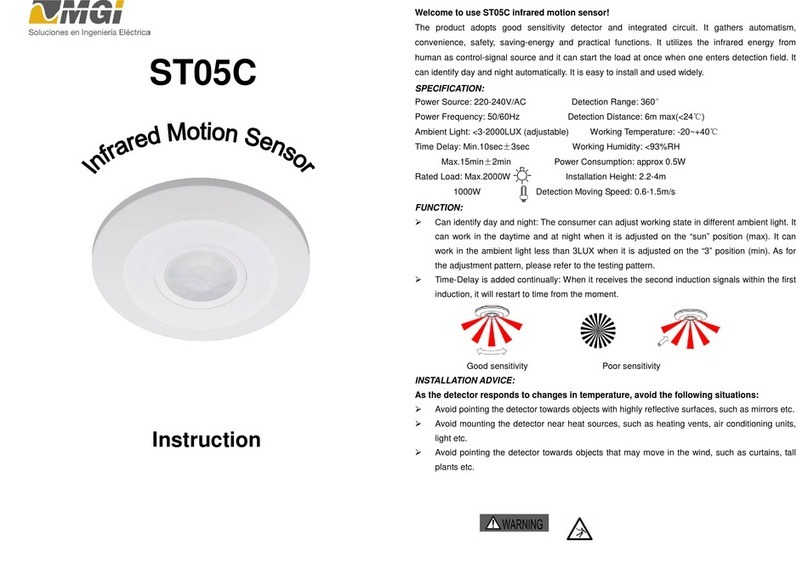SSP SAFIX User manual

Inhaltsverzeichnis
Version 4.0
December 2017
SAFIX
Safety sensor
EN Operating instructions
SSP Safety System Products GmbH & Co. KG
Max-Planck-Str. 21
D-78549 Spaichingen
www.safety-products.de
3 Mounting. . . . . . . . . . . . . . . . . . . . . . . . . . . . . . . . . . . . . . . . . . . . . . . . .3
3.1 General mounting instructions . . . . . . . . . . . . . . . . . . . . . . . . . . . . . . . . . . . . . .3
3.2 Mounting accessories . . . . . . . . . . . . . . . . . . . . . . . . . . . . . . . . . . . . . . . . . . . . .4
3.3 Dimensions. . . . . . . . . . . . . . . . . . . . . . . . . . . . . . . . . . . . . . . . . . . . . . . . . . . . .4
3.4 Switching distance . . . . . . . . . . . . . . . . . . . . . . . . . . . . . . . . . . . . . . . . . . . . . . .5
3.5 Adjustment. . . . . . . . . . . . . . . . . . . . . . . . . . . . . . . . . . . . . . . . . . . . . . . . . . . . .5
4 Electrical connection. . . . . . . . . . . . . . . . . . . . . . . . . . . . . . . . . . . . . . . .5
4.1 General information for electrical connection. . . . . . . . . . . . . . . . . . . . . . . . . . . .5
5 Operating principles and coding. . . . . . . . . . . . . . . . . . . . . . . . . . . . . . .5
5.1 Mode of operation of the safety outputs . . . . . . . . . . . . . . . . . . . . . . . . . . . . . . .5
5.2 Coding. . . . . . . . . . . . . . . . . . . . . . . . . . . . . . . . . . . . . . . . . . . . . . . . . . . . . . . .6
6 Diagnostic functions . . . . . . . . . . . . . . . . . . . . . . . . . . . . . . . . . . . . . . . .6
6.1 Operating principle of the diagnostic LED‘s . . . . . . . . . . . . . . . . . . . . . . . . . . . . .6
7 Set-up an maintenance . . . . . . . . . . . . . . . . . . . . . . . . . . . . . . . . . . . . . .7
7.1 Funktionsprüfung . . . . . . . . . . . . . . . . . . . . . . . . . . . . . . . . . . . . . . . . . . . . . . . .7
7.2 Wartung. . . . . . . . . . . . . . . . . . . . . . . . . . . . . . . . . . . . . . . . . . . . . . . . . . . . . . .7
8 Disassembly and disposal . . . . . . . . . . . . . . . . . . . . . . . . . . . . . . . . . . . .7
8.1 Disassembly . . . . . . . . . . . . . . . . . . . . . . . . . . . . . . . . . . . . . . . . . . . . . . . . . . . .7
8.2 Disposal . . . . . . . . . . . . . . . . . . . . . . . . . . . . . . . . . . . . . . . . . . . . . . . . . . . . . . .7
9 Appendix . . . . . . . . . . . . . . . . . . . . . . . . . . . . . . . . . . . . . . . . . . . . . . . . .8
9.1 Wiring examples. . . . . . . . . . . . . . . . . . . . . . . . . . . . . . . . . . . . . . . . . . . . . . . . .8
9.2 Anschlussbelegung und Zubehör Steckverbinder . . . . . . . . . . . . . . . . . . . . . . . . .9
10 Declaration of conformity. . . . . . . . . . . . . . . . . . . . . . . . . . . . . . . . . . .10
10.1 EU-Declaration of conformity . . . . . . . . . . . . . . . . . . . . . . . . . . . . . . . . . . . . . .10
1 About this document. . . . . . . . . . . . . . . . . . . . . . . . . . . . . . . . . . . . . . . .2
1.1 Function. . . . . . . . . . . . . . . . . . . . . . . . . . . . . . . . . . . . . . . . . . . . . . . . . . . . . . .2
1.2 Safety instructions for authorised qualified personnel . . . . . . . . . . . . . . . . . . . . .2
1.3 Symbols . . . . . . . . . . . . . . . . . . . . . . . . . . . . . . . . . . . . . . . . . . . . . . . . . . . . . . .2
1.4 Appropriate use . . . . . . . . . . . . . . . . . . . . . . . . . . . . . . . . . . . . . . . . . . . . . . . . .2
1.5 General safety instructions . . . . . . . . . . . . . . . . . . . . . . . . . . . . . . . . . . . . . . . . .2
1.6 Warning about misuse . . . . . . . . . . . . . . . . . . . . . . . . . . . . . . . . . . . . . . . . . . . .2
1.7 Exclusion of liability . . . . . . . . . . . . . . . . . . . . . . . . . . . . . . . . . . . . . . . . . . . . . .2
2 Product description. . . . . . . . . . . . . . . . . . . . . . . . . . . . . . . . . . . . . . . . .2
2.1 Ordering code. . . . . . . . . . . . . . . . . . . . . . . . . . . . . . . . . . . . . . . . . . . . . . . . . . .2
2.2 Special versions . . . . . . . . . . . . . . . . . . . . . . . . . . . . . . . . . . . . . . . . . . . . . . . . .2
2.3 Destination and use . . . . . . . . . . . . . . . . . . . . . . . . . . . . . . . . . . . . . . . . . . . . . .2
2.4 Series connection . . . . . . . . . . . . . . . . . . . . . . . . . . . . . . . . . . . . . . . . . . . . . . . .2
2.5 Technical data . . . . . . . . . . . . . . . . . . . . . . . . . . . . . . . . . . . . . . . . . . . . . . . . . .3
2.6 Safety classification. . . . . . . . . . . . . . . . . . . . . . . . . . . . . . . . . . . . . . . . . . . . . . .3
2.7 Forseeable defeat according to ISO 14119 . . . . . . . . . . . . . . . . . . . . . . . . . . . . .3
Translation of the original operating instructions
. All
rights reserved. Errors and omissions excepted.
Optionale Funktionen werden Ihnen ergänzend zu dieser
Betriebsanleitung entsprechend der Ausstattung Ihres
Gerätes in Form von Beiblättern zur Verfügung gestellt.

2 3
1. About this document
1.1 Function
This operating instructions manual provides all the information you need for the mounting,
set-up and commissioning to ensure the safe operation and disassembly of the safety swit-
chgear. The operating instructions must be available in a legible condition and a complete
version in the vicinity of the device.
1.2 Safety instructions for authorised qualified personnel
All operations described in this operating instructions manual must be carried out by trained
specialist personnel, authorised by the plant operator only. Please make sure that you have
read and understood these operating instructions and that you know all applicable legisla-
tions regarding occupational safety and accident prevention prior to installation and putting
the component into operation. The machine builder must carefully select the harmonised
standards to be complied with as well as other technical specifications for the selection,
mounting and integration of the components.
1.3 Symbols
Caution
Failure to comply with this warning notice could lead to physical injury and/or
damage to the machine.
Information
Hilfreiche Zusatzinformationen
1.4 Appropriate use
The products described in these operating instructions are developed to execute safety-related
functions as part of an entire plant or machine. It is the responsibility of the manufacturer
of a machine or plant to ensure the correct functionality of the entire machinery or plant.
The safety switchgear must be exclusively used in accordance with the versions listed below
or for the applications authorised by the manufacturer. Detailed information regarding the
range of applications can be found in the chapter „2. Product description“.
1.5 General safety instructions
The user must observe the safety instructions in this operating instructions manual,labelled
with the caution or warning symbol above, the country-specific installation standards as
well as all prevailing safety regulations and accident prevention rules.
Further technical information can be found in the SSP catalogues or in the
online catalogue on the Internet: www.safety-products.de.
The information contained in this operating instructions manual is provided without liability
and is subject to technical modifications.
There are no residual risks, provided that the safety instructions as well as the instructions
regarding mounting, commissioning, operation and maintenance are observed.
1.6 Warning about misuse
In case of inadequate or improper use or manipulations of the safety switchgear,
personal hazards or damages to machinery or plant components cannot be
excluded. The relevant requirements of the standard
ISO 14119 must be observed.
1.7 Exclusion of liability
We shall accept no liability for damages and malfunctions resulting from defective mounting
or failure to comply with this operating instructions manual.The manufacturer shall accept
no liability for damages resulting from the use of unauthorised spare parts or accessories.
For safety reasons, invasive work on the device as well as arbitrary repairs, conversions
and modifications to the device are strictly forbidden; the manufacturer shall accept no
liability for damages resulting from such invasive work, arbitrary repairs, conversions and/
or modifications to the device.
2. Product description
2.1 Ordering code
This operating instructions manual applies to the following types:
Type code SAFIX ➀ ➁
➀Coding variations
S Standard coding
I Individual coding
W Individual coding, re-teachable
T Transmitter (actuator)
➁Option
1 Diagnostic output
3 Standard actuator
4 Flacher actuator
2.2 Special versions
For special versions, which are not listed in the order code below 2.1, these specifications
apply accordingly, provided that they correspond to the standard version.
2.3 Destination and use
This non-contact, electronic safety switch is designed for application in safety circuits and
is used for monitoring the position of movable safety guards. In this application, the safety
switch monitors the position of hinged, sliding or removable safety guards by means of
the coded electronic actuator.
The safety function consists of safely switching off the safety outputs when the safety guard
is opened and maintaining the safe switched off condition of the safety outputs for as long
as the safety guard is open.
2.4 Series connection
Series connection can be set up. The response and risk times are not altered by wiring in
series.The number of components is only limited by the external cable protection according
to the technical data and the line loss.
Protection is not required when pilot wires are laid.The cables however must be separated
from the supply and energy cables. The max. fuse rate for a sensor chain depends on the
section of the connecting cable of the sensor.
The entire concept of the control system, in which the safety component is
integrated, must be validated to the relevant standards.
2.5 Technical data
Standards: IEC 60947-5-3, IEC 61508, ISO 13849-1
Enclosure: Thermoplastic hotmelt
Operating principle: RFID
Frequency band: 125 kHz
Transmission power: max. -6 dBm
Actuator: SAFIX T3
Series connections: Unlimited number of components,
lease observe external cable protection
Connection: Connector plug M8, 8-pole,A-coded
Switching distances according to IEC 60947-5-3
Typical switching distance: 12 mm;
- lateral actuation: 9 mm
assured switching distance Sao: 10 mm;
- lateral actuation: 6 mm
assured swtiching distance Sar: 18 mm;
- lateral actuation: 15 mm
Hysteresis: < 2,0 mm
Repeat accuracy R: < 0,5 mm
Ambient conditions
Ambient temperature Tu: −25 °C … +65 °C
Storage and transprot temperature: −25 °C … +85 °C
Protection class: IP65 / IP67 to IEC 60529
Resistance to vibration: 10 … 55 Hz, Amplitude 1 mm
Resistance to shock: 30 g / 11 ms
Switching frequency f: 1 Hz
Drop-out time:
- Actuator ≤ 100 ms
Duration of risk: ≤ 200 ms
Time to readiness: ≤ 2 s
Electrical data
Rated operating voltage Ue: 24 VDC −15% / +10%
(PELV to IEC 60204-1)
Rated operating current Ie: 0,6 A
Minimum operating current Im: 0,5 mA
Required rated short-circuit current: 100 A
Rated insulation voltage Ui: 32 V
Rated impulse withstand voltage Uimp: 800 V
No-load current Io: 35 mA
Overvoltage category: III
Degree of pollution: 3
Safety inputs X1/X2
Rated operating voltage Ue1: 24 VDC −15% / +10%
(PELV unit)
Power consumption per input: 5 mA
Safety outputs Y1/Y2 p-type, short-circuit proof
Operating current Ie1: max. 0,25 A
Utilisation category: DC-12: Ue/Ie: 24 VDC / 0,25 A;
DC-13: Ue/Ie: 24 VDC / 0,25 A
Voltage drop: Ue < 1 V
Diagnostic output p-type, short-circuit proof
Operating current Ie2: max. 0,05 A
Utilisation category: DC-12: Ue/Ie: 24 VDC / 0,05 A;
DC-13: Ue/Ie: 24 VDC / 0,05 A
Voltage drop: Ue < 2 V
Operating current: 150 mA
Wiring capacitance: max. 50 nF
Device fuse rating: ≤ 2 A bei Einsatz gemäß UL 508
2.6 Safety classification
Standards: EN ISO 13849-1, IEC 61508, IEC 62061
PL: e
Category: 4
PFH value: 6,8 x 10-10 / h
PFD: 1,2 x 10-4
SIL: suitable for SIL 3 applications
Service life: 20 years
2.7 Forseeable defeat according to ISO 14119
SAFIX S low coding level
SAFIX I high coding level
SAFIX W high coding level
3. Mounting
3.1 General mounting instructions
During fitting, the requirements of ISO 14119 must be observed.
The mounting holes provide for a variable mounting by means of M4 screws (max.tightening
torque 0.8 Nm). The component can be mounted in any position. The labelled surfaces of
the safety switch and the actuator have to be opposite.The safety switch must only be used
within the assured switching distances ≤ sao and ≥ sar.
Safety switch and actuator must be permanently fitted to the safety guards
and protected against displacement by suitable measures (tamperproof screws,
gluing, drilling of the screw heads).
The mounting holes provide for a variable mounting by means of M4 screws (max.tightening
torque 0.8 Nm). The component can be mounted in any position. The labelled surfaces of
the safety switch and the actuator have to be opposite.The safety switch must only be used
within the assured switching distanTo avoid any interference inherent to this kind of system
and any reduction of the switching distances, please observe the following guidelines:
• The presence of metal chips in the vicinity of the sensor is liable to modify the switching
distance.
• Keep away from metal chips.
• Minimum distance between two sensors: 100 mmes ≤ sao and ≥ sar.
Wrong Right
100 mm

4 5
3.2 Mounting accessories
(to be ordered separately)
Kit tamper-proof screws
• SAFIX Z S20: 4 × M4x20 incl. washers, SP-K-71-000-00
• SAFIX Z S25: 4 × M4x25 incl. washers, SP-K-71-000-01
Sealing kit SAFIX Z D
• Article number SP-K-71-000-02
• Plugs: 4 flat pieces for flush finish and 4 with border for high screw heads
• To seal the mounting holes: Flush one-way plugs for flat screw heads, also suitable as
tampering protection for the screw fixings
12
12
16
15
18
12
18
Mounting set SAFIX Z M
• Article number SP-K-71-000-03
• Alternative use of the mounting plates or ferrules
• Mounting plates: 2 pieces for mounting on non-linear stable basis, e.g. on groove
rails/profiles
• Ferrules: 4 pieces for insertion to secure the screw fixings to the mounting surface for
applications with regular high temperature variations
3.3 Dimensions
All measurements in mm.
Safety switch SAFIX _ _
1910.5
22
39.2
47.5
18
Actuator SAFIX T3
19
39
Alternative suitable actuators with different design, refer to
www.safety-products.de.
3.4 Actuating directions
Frontal actuation
Side actuation
Lateral actuation only from the shown sensor side.
3.5 Switching distance
The side allows for a maximum height misalignment (X) of sensor and actuator of ± 8
mm (e.g. mounting tolerance or due to guard door sagging).The axial misalignment (y) is
max. ± 18 mm.
Y
X
3.6 Adjustment
The continuous signal of the yellow LED signals the actuator detection.
Reccomended Adjustment
Align the safety switch and actuator at a distance of 0,5 x sao.
The correct functionality of both safety channels must be checked by means of the connected
safety-monitoring module.
Actuating curves
The actuating curves represent the typical switching distance of the safety switch during
the approach of the actuator subject to the actuating direction
Transverse misalignment
-5-20 51015-15
20
-10 0
Y [mm]
S [mm]
0
5
10
12
Height misalignment
-5-20-24 51015-15 20
24
-10 0
X [mm]
S [mm]
0
5
10
12
Preferred actuation directions: from front or from side
In case of a lateral actuation,the switching distances are reduced by approx.3 mm.
4. Electrical connection
4.1 General information for electrical connection
The electrical connection may only be carried out by authorised personnel in
a de-energised condition.
The safety outputs can be integrated in the safety circuit of the control system.For applications
of PL e / control category 4 to ISO 13849-1, the safety outputs of the safety switch or of the
sensor chain must be wired to a safety monitoring-module of the same control category.
Requirements for the connected safety-monitoring module
Dual-channel safety input, suitable for p-type sensors with NO function
Possible monitoring modules by SSP:
SP-S-00-003-01 Serie S
SP-S-00-003-02 Serie T
SP-R-11-000-00 Mosaic M1
www.safety-products.de
If the safety switch is wired to relays or to non-safety relevant control components, a new
risk analysis must be carried out.
The sensors cyclically switch off the safety output to test them.The safety-monitoring module
therefore does not need to be equipped with a cross-wire short detection. The switch-off
times must be tolerated by the safety-monitoring module.The switch-off time of the safety
switch is additionally extended depending on the cable length and the capacity of the
cable used. Typically, a switch-off time of 250 μs is reached with a 30-m connecting cable.
Configuration of the safety-monitoring module
If the safety switch is connected to electronic safety-monitoring modules, we
recommend that you set a discrepancy time of 100 ms.The safety inputs of the
safety-monitoring module must be able blanking a test impulse of approx.1 ms.
5. Operating principles and coding
5.1 Mode of operation of the safety outputs
The safety outputs can be integrated in the safety circuit of the control system.The opening
of a safety guard,i.e. the actuator is removed out of the active zone of the sensor,will imme-
diately disable the safety outputs of the sensor (switching distances refer to technical data).
Any error that does not immediately affect the functionality of the safety switch (e.g.too high
the ambient temperature,interference potential at a safety output,cross-wire short) will lead
to a warning message, the disabling of the diagnostic output and the delayed shut-down of
the safety outputs.The safety outputs are disabled if the error warning is active for 30 minutes.
The signal „combination, diagnostic output disabled“ and „safety channels still enabled“,
can be used to stop the production process in a controlled manner.
After fault rectification,the error message is reset by opening and re-closing the corresponding
safety guard. The safety outputs enable and allow a restart.
Y
X

6 7
5.2 Coding
Safety switchs with standard coding are ready to use upon delivery.
Individually coded safety switchs and actuators will require the following „teach-in“ procedure:
• Switch the safety switch‘s voltage supply off and back on.
• Introduce the actuator in the detection range.The teach-in procedure is signalled at the
safety switch, red LED on, yellow LED flashes (1 Hz).
• After 10 seconds, brief cyclic flashes (3 Hz) request the switch-off of the operating vol-
tage of the safety switch. (If the voltage is not switched off within 5 minutes, the safety
switch cancels the „teach-in“ procedure and signals a false actuator by 5 red flashes).
• After the operating voltage is switched back on, the actuator must be detected once
more in order to activate the taught actuator code. In this way, the activated code is
definitively saved!
For ordering suffix _I,the thus executed allocation of safety switch and actuator is irreversible.
For ordering suffix _W, the „teach-in“ procedure for a new actuator can be repeated an
unlimited number of times. When a new actuator is taught, the code,which was applicable
until that moment, becomes invalid. Subsequent to that, an enabling inhibit will be active
for ten minutes, thus providing for an increased protection against tampering. The green
LED will flash until the expiration of the time of the enabling inhibit and the detection of
the new actuator.
The 10-minutes protection time will subsequently restart in case of a power failure during
the lapse of time.
6. Diagnostic functions
6.1 Operating principle of the diagnostic LED‘s
The safety switch indicates the operating condition and faults by means of three-colour
LED‘s located in the lateral surfaces of the sensor.
The green LED indicates that the safety switch is ready for operation.The supply voltage is
onand all safety inputs are present. If the green LED is flashing(1 Hz), it signalizes an error
within one or two safety inputs (X1 and/or X2).
The yellow LED signalizes an actuator in detection range. Is the acuator located on the
threshold of the sensor‘s switching distance, will it be indicated with a flash.
The flashing can be used to prematurely detect variations in the clearance between the sensor
and the actuator (e.g. sagging of a safety guard). The sensor must be adjusted before the
distance to the actuator increases and before the safety outputs are disabled, thus stopping
the machine. If an error is detected, the red LED will be activated.
Blinkcodes diagnostic LED‘s
LED indication (red) Error cause
1 flash pulse Error output Y1
2 flash pulses Error output Y2
3 flash pulses Cross-wire Y1/Y2
4 flash pulses Ambient temperature too high
5 flash pulses incorrect or defective actuator
Continuous red Internal fault
Continuous red
with yellow flashing
Teaching procedure
6.2 Operating principle of the electronic diagnostic output
A diagnostic output additionally indicates the operating condition (refer to table 1). These
signals can be used in a downstream control.
The short-circuit proof diagnostic output OUT can be used for central visualisation or control
functions, e.g. in a PLC. It indicates the switching condition as shown in the table 1.
Error
Errors, which no longer guarantee the function of the safety switch (internal errors) cause
the safety outputs to be disabled within the risk time. Any error that does not immediately
affect the safe functionality of the safety switch (e.g. the ambient temperature too high,
interference potential at a safety output, cross-wire short) will lead to a delayed shut-down
(refer to table 2).
After the rectification of the error, the error message is reset by opening the corresponding
safety guard.
Erorr warning
The diagnostic output can also be used to detect clearance variations between the sensor
and the actuator in the same way as the yellow LED. An active fault is visualised by the
red LED and causes the diagnostic output to be disabled. The safety outputs are disabled
after max. 30 minutes if the fault is not rectified.This signal combination, diagnostic output
disabled and safety channels still enabled, can be used to stop the production process in
a controlled manner.
Tabele 1: Examples of the diagnostic function of the safety-sensor
Sensor function LED`s Diagnostic output Safety output Note
Green Red Yellow Y1, Y2
I. Supply voltage on off off 0 V 0 V Voltage on, no evaluation of the voltage quality
II. Actuated on off on 24 V 24 V The yellow LED always signals the presence of an actuator within range
III. Actuated in limit area on off flashes
(1Hz)
24 V
pulsed
24 V The sensor must be adjusted before the distance to the actuator increases
and before the safety outputs are disabled, thus stopping the machine
IV. Error warning, sensor actuated off flashes on 0 V 24 V After 30 minutes if the error is not rectified
V. Error off flashes on 0 V 0 V Refer to table with flash codes
VI. Teach target off on flashes 0 V 0 V Sensor in teaching mode
VII. Protection time flashes
(1Hz)
off off 0 V 0 V 10 minutes pause after re-teaching
Door is closed,target teached (function is only active in teaching mode)
VIII.
Error in the input circuit X1, X2 flashes
(1Hz)
off off 0 V 0 V
Error in input circuit X1 or X2.
Example: Door open, one door in the safety circuit before is opened aswell.
IX.
Error in the input circuit X1, X2 flashes
(1Hz)
off on 24
V
0 V
Error in input circuit X1 or X2.
Example: Door closed, one door in the safety circuit before is opened aswell.
See table „
Operating principle of the diagnostic LED‘s
„ section 6.1
8. Disassembly and disposal
8.1 Disassembly
The safety switchgear must be disassembled in a de-energised condition only.
8.2 Disposal
The safety switchgear must be disposed of in an appropriate manner in accordance with
the national prescriptions and legislations.
7. Set-up an maintenance
7.1 Functional testing
The safety function of the safety components must be tested.The following conditions must
be previously checked and met:
• Fitting of the sensor and the actuator.
• Fitting and integrity of the power cable.
• The system is free of dirt and soiling (in particular metal chips).
7.2 Maintenance
In the case of correct installation and adequate use, the safety switch features maintenan-
ce-free functionality.
A regular visual inspection and functional test,including the following steps,is recommended:
1. Check the fitting and integrity of the safety switch, the actuator and the cable.
2. Remove possible metal chips.
Damaged or defective components must be replaced.

8 9
9. Appendix
9.1 Wiring examples
The application examples shown are suggestions.They however do not release the user from carefully checking whether the switchgear and its set-up are suitable for the individual application.
Wiring example 1:
Wiring of SAFIX with diagnostic output
Wiring example 2:
Series-wiring of SAFIX with diagnostic output
Input X1 and X2 will be connected with 24 V DC.
Output Y1 and Y2 are wired to the safety-monitoring module.
The diagnostic output can be connected for instance with a PLC.
The voltage is supplied to both safety inputs of the last safety switch of the chain (con-
sidered from the safety-monitoring module).The safety outputs of the first safety switch
are wired to the safety-monitoring module.The diagnostic output can be connected for
instance to a PLC.
L
EANSAFE S
24V DC
GND
52613748
CLP/SPS
TUOOFNI
1X
2X
1A
2A
DSSO2Y
DSSO1Y
LEANSAFE E
13 23 33 41
14 24 34 42
K2
K1
A1 S33 S34 S35 13 23 33
A2 S21 S22 S12 S31 S11 14 24 34
TESER
3444
1
2
L
EANSAFE S
5
2
6
1
3
7
4
8
CLP/SPS
TUOOFNI
1X
2X
1A
2A
DSSO2Y
DSSO1Y
24V DC
GND
5
2
6
1
3
7
4
8
CLP/SPS
TUOOFNI
1X
2X
1A
2A
DSSO2Y
DSSO1Y
LEANSAFE E
13 23 33 41
14 24 34 42
K2
K1
A1 S33 S34 S35 13 23 33
A2 S21 S22 S12 S31 S11 14 24 34
TESER
3444
1
2
1
2
Y1 and Y2 = Safety outputs dual-channel safety monitoring module
9.2 Anschlussbelegung und Zubehör Steckverbinder
Function safety switchgear Pin configuration of
the connector
Possible colour codes of other customary connectors
with diagnostic output to EN 60947-5-2: 2007
A1
U
e
1 BN
X1
Safety input 1
2 WH
A2
GND
3 BU
Y1
Safety output 1
4 BK
OUT
Diagnostic output
5 GY
X2
Safety input 2
6 PK
Y2
Safety output 2
7 VT
IN
without function
8 OR
Colour code
Code
Colour
Code
Colour
Code
Colour
Code
Colour
BK
black
GN
green
PK
pink
WH
white
BN
brown
GY
grey
RD
red
YE
yellow
BU
blue
OR
orange
VT
violet
Connectin cables with coupling (female)
IP67, M8, 8-pole - 8 x 0,25 mm², straight
Cable length Article number
5 m
10 m
20 m
SP-X-33-000-00
SP-X-33-000-01
SP-X-33-000-02
Connectin cables with coupling (female)
IP67, M8, 8-pole - 8 x 0,25 mm², angled
Cable length Article number
5 m
10 m
20 m
SP-X-33-000-03
SP-X-33-000-04
SP-X-33-000-05
Connection adapter M8 coupling M12 connector, IP
67, 8-pole - 8 x 0,25 mm²
Cable length Article number
2 m SP-X-33-000-06

10
10.1 EU-Declaration of conformity
10. Declaration of conformity
Hinweis
The currently valid declaration of conformity can be downloaded from our
website: www.safety-products.de
EU Declaration of conformity SSP Safety System Products GmbH & Co. KG
Max-Planck-Straße 21
78549 Spaichingen
Deutschland
www.safety-products.de
We hereby certify that the hereafter described safety components both in its basic design and construction conform to the applicable European Directives.
Name of the safety component SAFIX 3
Type See ordering code
Description Non-contact safety sensor
Relevant Directives Machinery Directive
EMC-Directive
R&TTE-/RED-Directive
RoHS-Directive
2006/42/EC
2014/30/EU
2014/53/EU
2011/65/EU
Applied standards EN 60947-5-3:2013
EN 300 330 V2.1.1:2017
ISO 14119:2013
EN ISO 13849-1:2008 + AC:2009
IEC 61508 Teile 1-7:2010
EN 62061:2005 + AC:2010 + A1:2013
Notified body for the prototype test TÜV Rheinland Industrie Service GmbH
Alboinstr. 56, 12103 Berlin
ID n°: 0035
EC-prototype test certificate 01/205/5416.00/14
Person authorised for the compilation of the technical documentation Wolfgang Engelhart
Max-Planck-Straße 21
78549 Spaichingen
Place and date of issue Spaichingen, November 14th, 2017
Authorised signature
Johann Aulila
Managing Director
Wolfgang Engelhart
Deputy Managing Director
SSP Safety System Products GmbH & Co. KG
Max-Planck-Straße 21
78549 Spaichingen, Germany
+49 7424 98 049-0
info@ssp.de.com
www.safety-products.de
Table of contents
Popular Security Sensor manuals by other brands
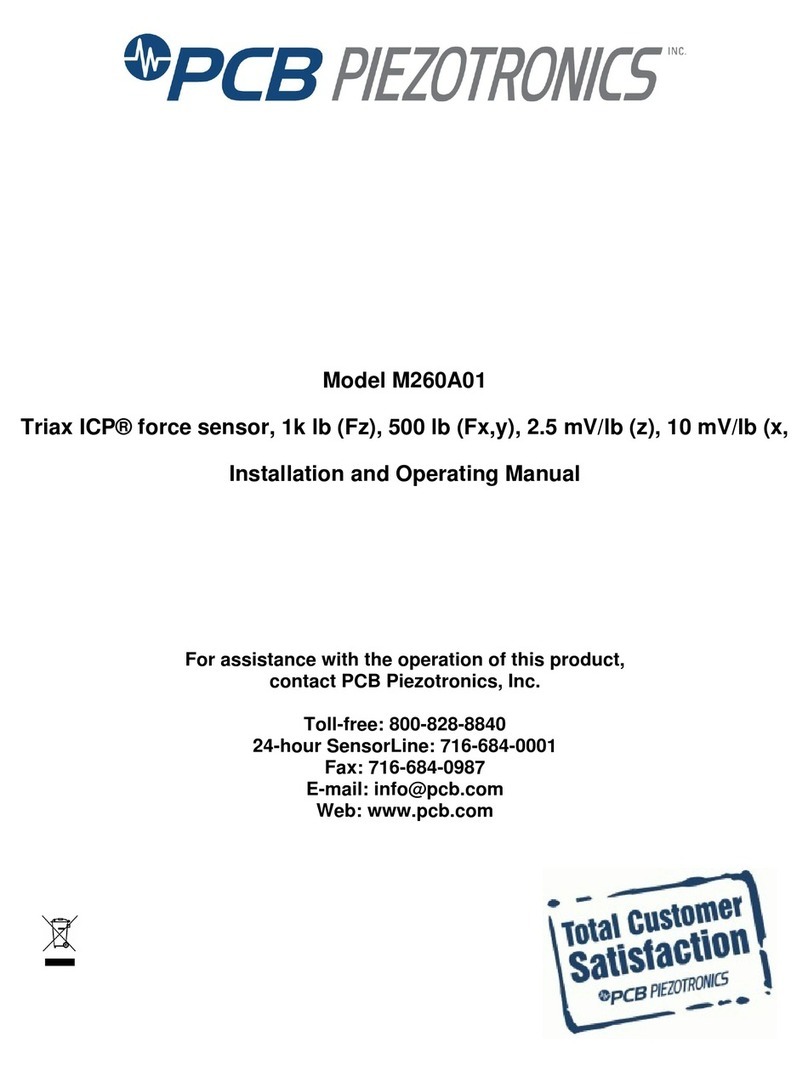
PCB Piezotronics
PCB Piezotronics ICP M260A01 Installation and operating manual
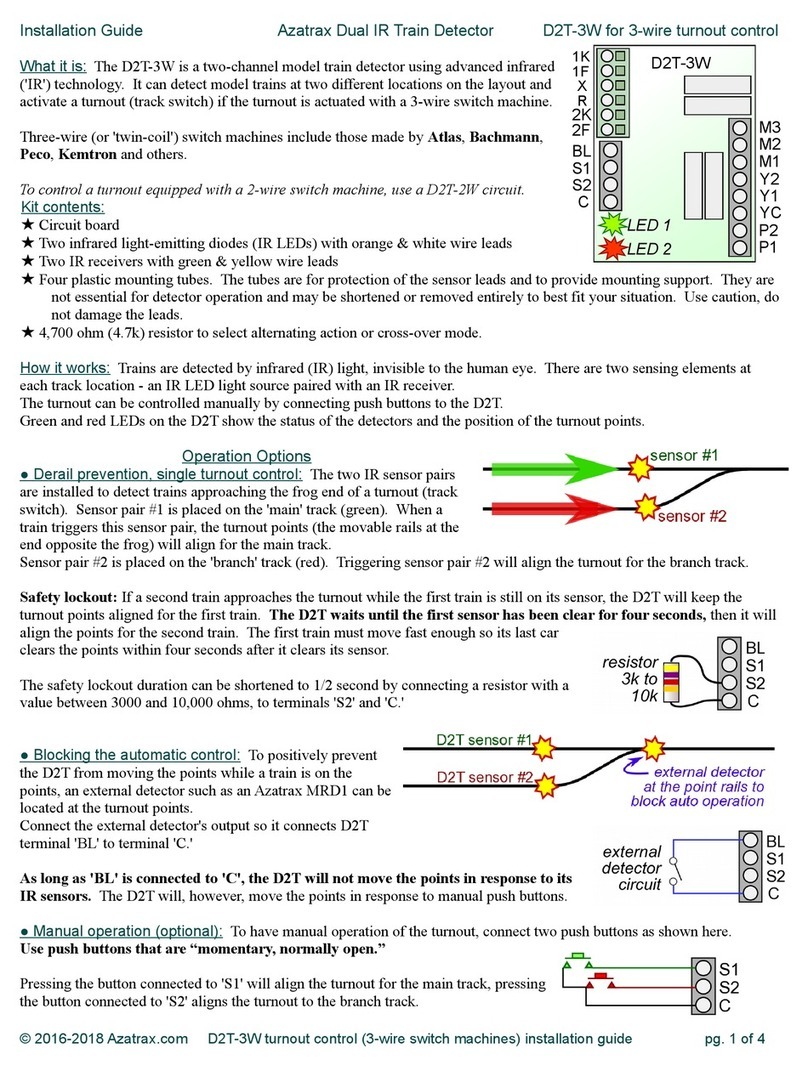
Azatrax
Azatrax D2T-3W installation guide

Bolid Security Systems
Bolid Security Systems S2000-IP instruction manual

ORBILOC
ORBILOC OUTDOOR DUAL user guide
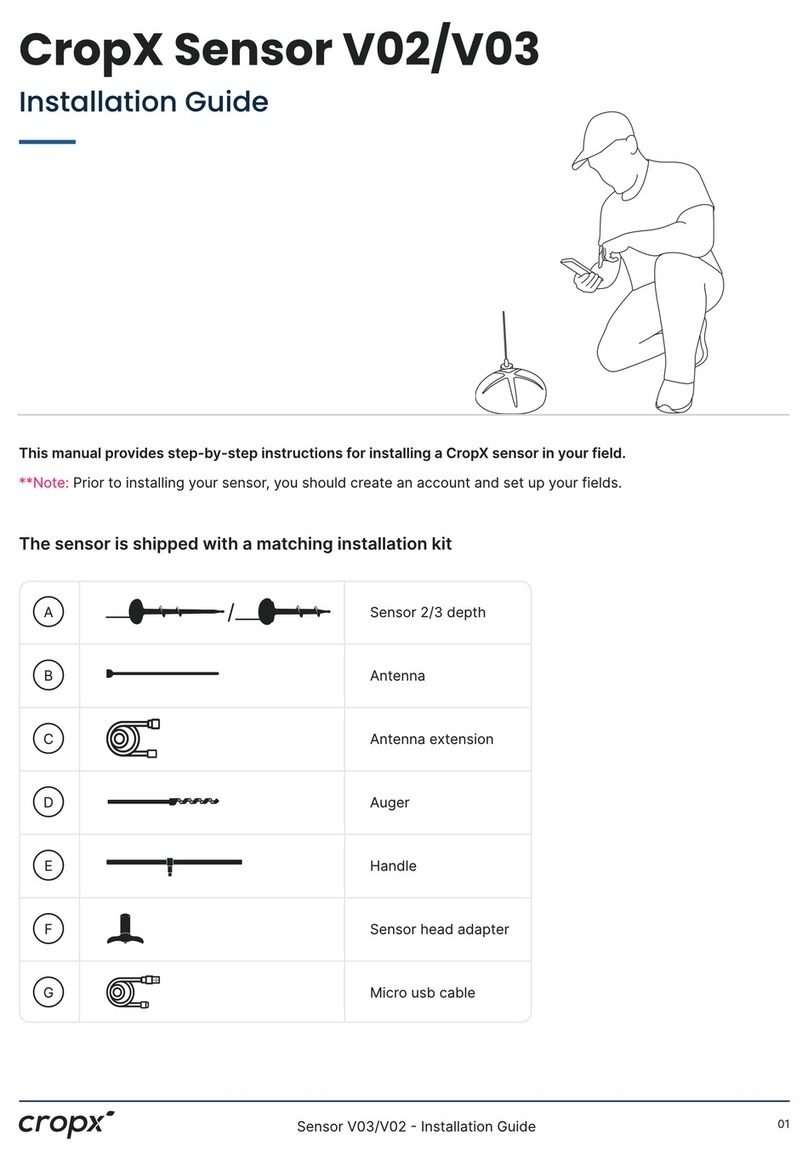
CropX
CropX V02 installation guide
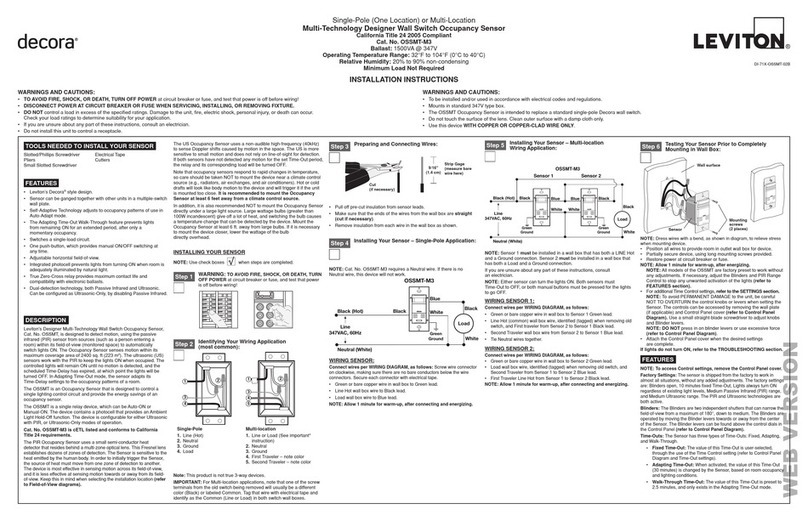
Leviton
Leviton decora OSSMT-M3 installation instructions
